Abstract
Biochemical and serological characteristics of 128 strains of Propionibacterium acnes isolated from the facial skin of healthy Japanese volunteers were compared with the three standard strains of the American Type Culture Collection, ATCC 6919, 11827, and 11828. Accordingly, the isolated strains of P. acnes were classified into five biotypes (B1 to B5) on the basis of fermentation tests of ribose, erythritol, and sorbitol. Two serotypes were distinguished by the agglutination test. P. acnes belonging to serotype I had galactose as a cell wall sugar, whereas those of serotype II lacked galactose. The strains of serotype I were distributed among all five biotypes (B1 to B5); however, those of serotype II consisted only of one biotype (B2). A term "sero-biotype" was introduced to differentiate and carefully classify the isolates. The predominant sero-biotypes differed with the individual and region of the facial skin. In general, strains of sero-biotype IB1, IB3, IB4, and IIB2 were more frequently isolated than those of sero-biotype IB2 and IB5. Thus, for routine assay work, serotyping of P. acnes as based on erythritol and sorbitol fermentation is both practical and applicable.
Full text
PDF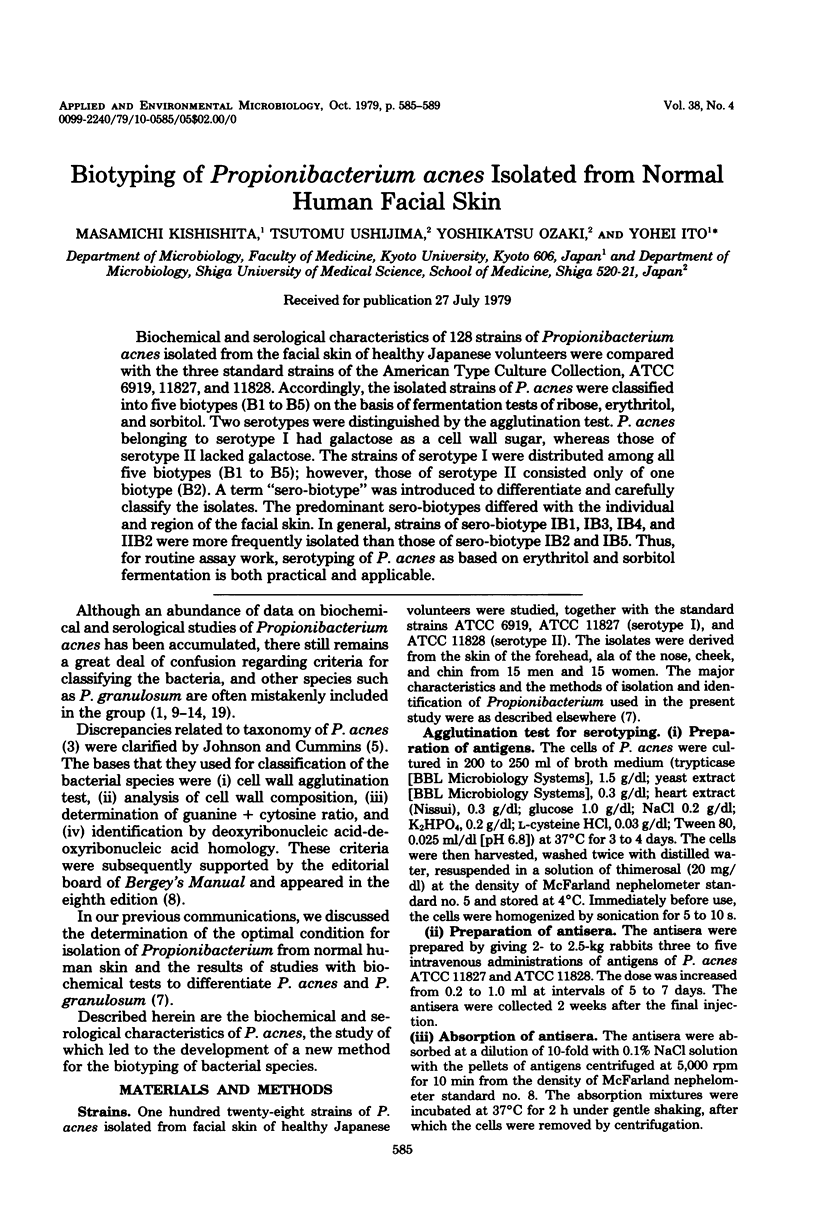
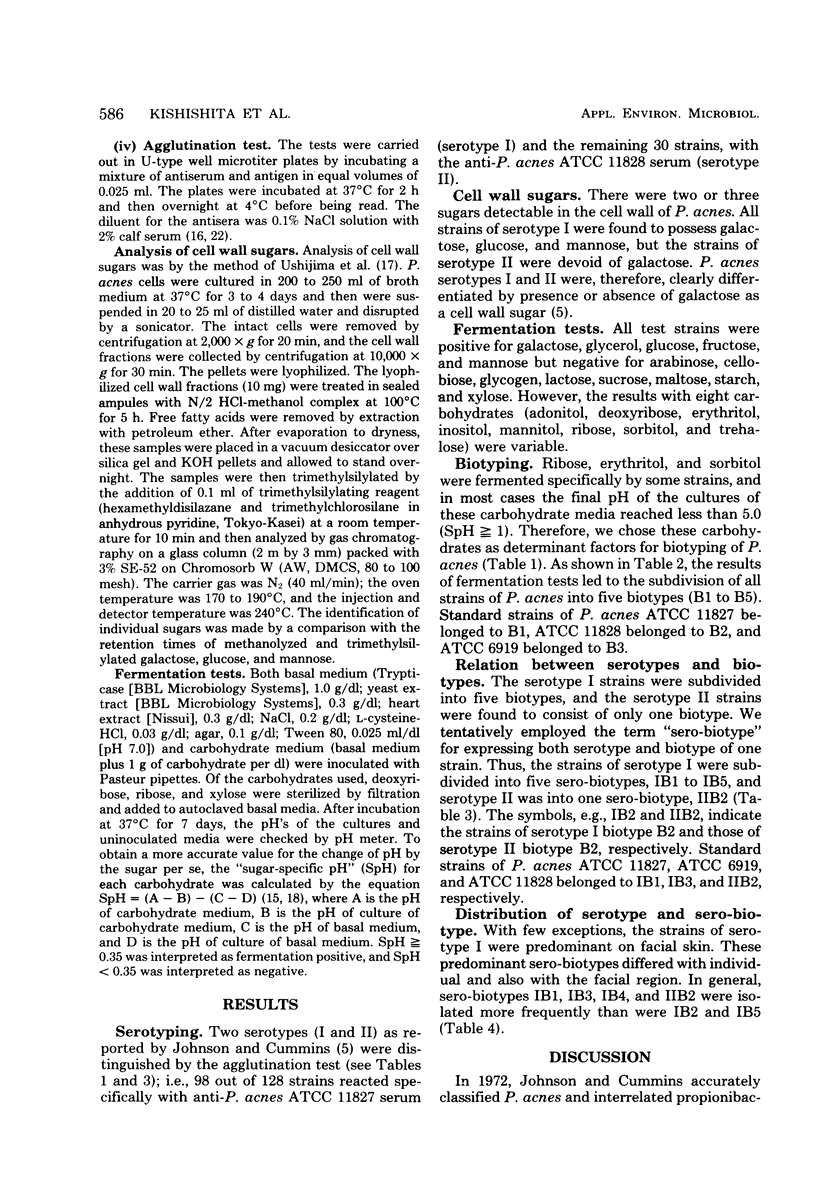
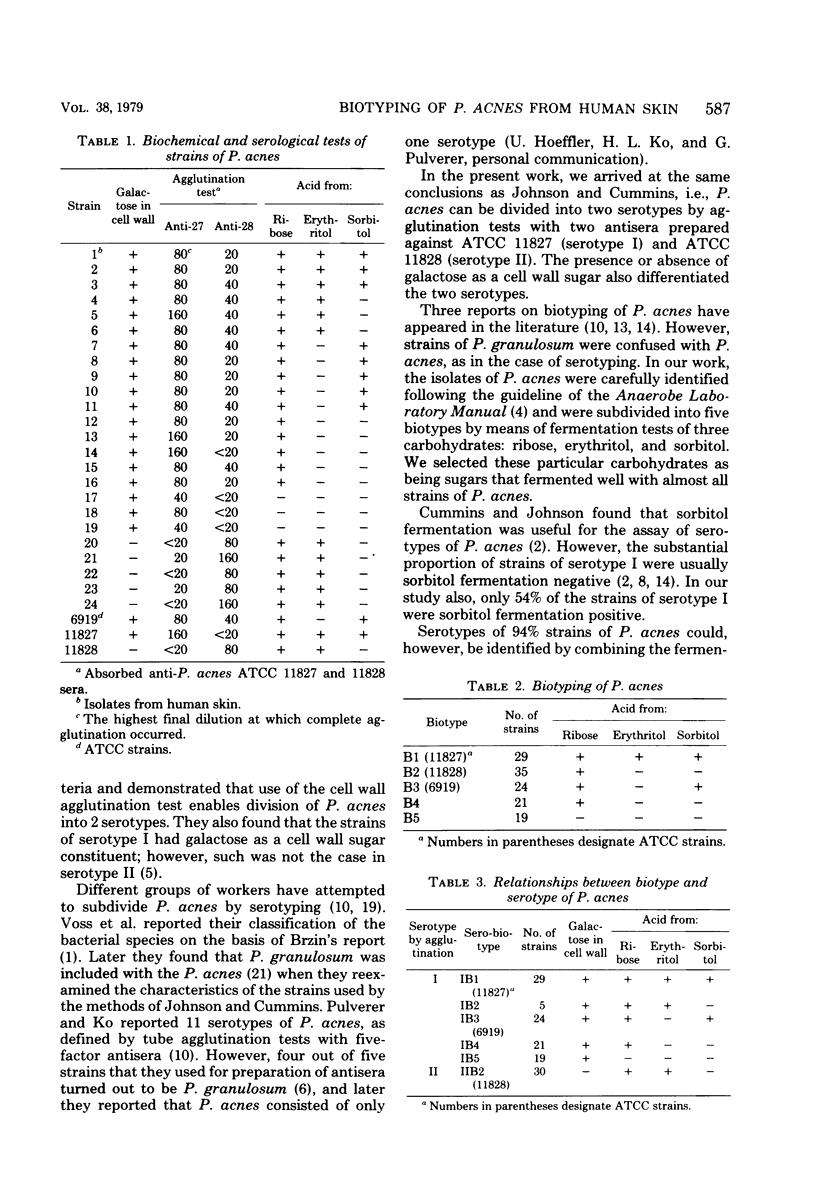
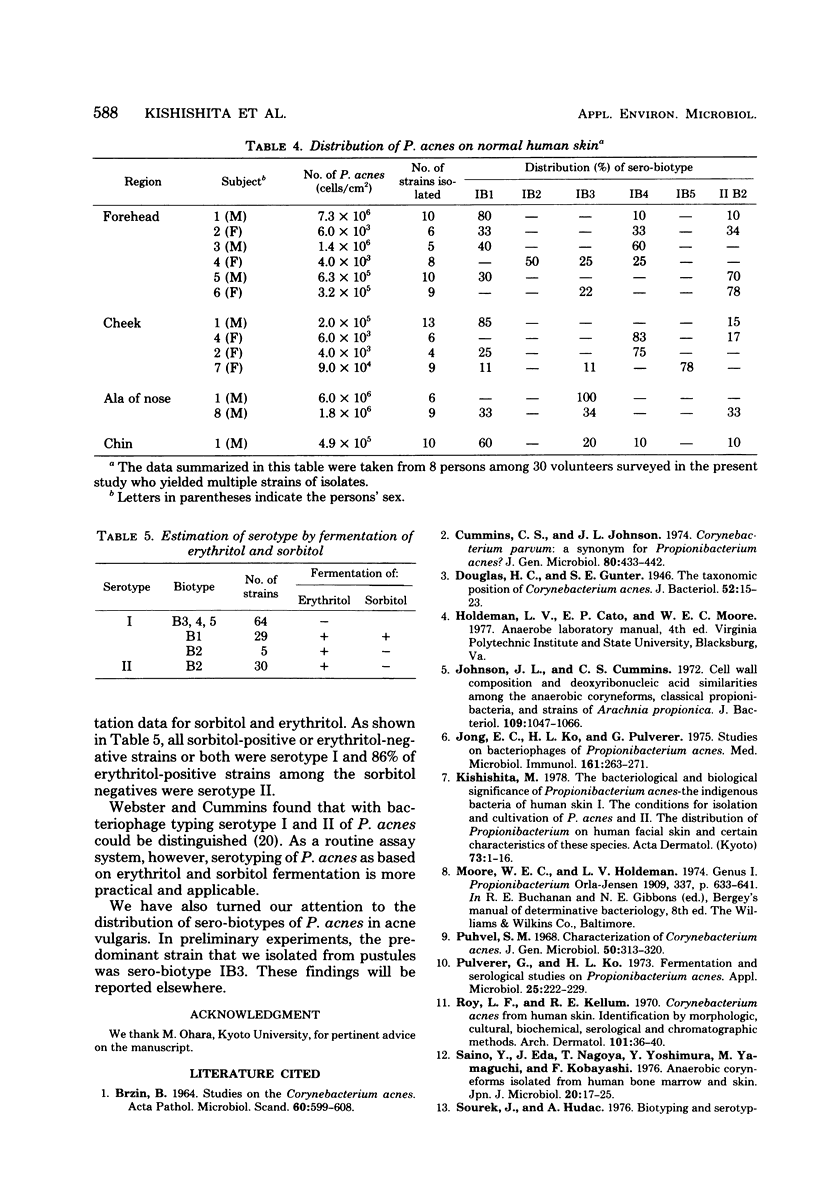
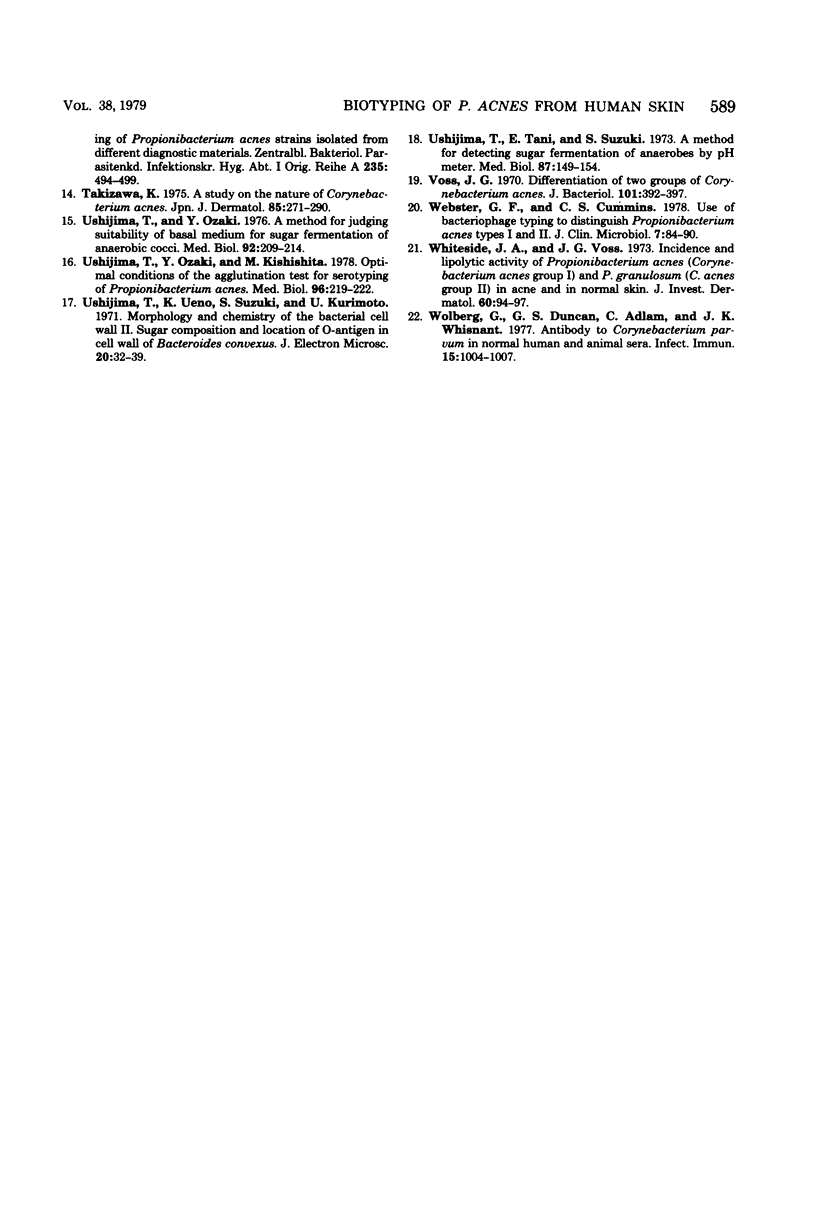
Selected References
These references are in PubMed. This may not be the complete list of references from this article.
- BRZIN B. STUDIES ON THE CORYNEBACTERIUM ACNES. Acta Pathol Microbiol Scand. 1964;60:599–608. doi: 10.1111/apm.1964.60.4.599. [DOI] [PubMed] [Google Scholar]
- Cummins C. S., Johnson J. L. Corynebacterium parvum: a synonym for Propionibacterium acnes? J Gen Microbiol. 1974 Feb;80(2):433–442. doi: 10.1099/00221287-80-2-433. [DOI] [PubMed] [Google Scholar]
- Douglas H. C., Gunter S. E. The Taxonomic Position of Corynebacterium acnes. J Bacteriol. 1946 Jul;52(1):15–23. [PMC free article] [PubMed] [Google Scholar]
- Johnson J. L., Cummins C. S. Cell wall composition and deoxyribonucleic acid similarities among the anaerobic coryneforms, classical propionibacteria, and strains of Arachnia propionica. J Bacteriol. 1972 Mar;109(3):1047–1066. doi: 10.1128/jb.109.3.1047-1066.1972. [DOI] [PMC free article] [PubMed] [Google Scholar]
- Jong E. C., Ko H. L., Pulverer G. Studies on bacteriophages of Propionibacterium acnes. Med Microbiol Immunol. 1975 Sep 19;161(4):263–271. doi: 10.1007/BF02122714. [DOI] [PubMed] [Google Scholar]
- Puhvel S. M. Characterization of Corynebacterium acnes. J Gen Microbiol. 1968 Feb;50(2):313–320. doi: 10.1099/00221287-50-2-313. [DOI] [PubMed] [Google Scholar]
- Pulverer G., Ko H. L. Fermentative and serological studies on Propionibacterium acnes. Appl Microbiol. 1973 Feb;25(2):222–229. doi: 10.1128/am.25.2.222-229.1973. [DOI] [PMC free article] [PubMed] [Google Scholar]
- Ray L. F., Kellum R. E. Corynebacterium acnes from human skin. Identification by morphologic, cultural, biochemical, serological, and chromatographic methods. Arch Dermatol. 1970 Jan;101(1):36–40. doi: 10.1001/archderm.101.1.36. [DOI] [PubMed] [Google Scholar]
- Saino Y., Eda J., Nagoya T., Yoshimura Y., Yamaguchi M. Anaerobic coryneforms isolated from human bone marrow and skin. Chemical, biochemical and serological studies and some of their biological activities. Jpn J Microbiol. 1976 Feb;20(1):17–25. doi: 10.1111/j.1348-0421.1976.tb00903.x. [DOI] [PubMed] [Google Scholar]
- Sourek J., Hudác A. Biotyping and serotyping of Propionibacterium acnes strains isolated from different diagnostic materials. Zentralbl Bakteriol Orig A. 1976 Aug;235(4):494–499. [PubMed] [Google Scholar]
- Takizawa K. [A study on the nature of Corynebacterium acnes (author's transl)]. Nihon Hifuka Gakkai Zasshi. 1975 Apr 15;85(5):271–290. [PubMed] [Google Scholar]
- Ushijima T., Ueno K., Suzuki S., Kurimoto U. Morphology and chemistry of the bacterial cell wall. II. Sugar composition and location of O-antigen in the cell wall of Bacteroides convexus. J Electron Microsc (Tokyo) 1971;20(1):32–39. [PubMed] [Google Scholar]
- Webster G. F., Cummins C. S. Use of bacteriophage typing to distinguish Propionibacterium acne types I and II. J Clin Microbiol. 1978 Jan;7(1):84–90. doi: 10.1128/jcm.7.1.84-90.1978. [DOI] [PMC free article] [PubMed] [Google Scholar]
- Whiteside J. A., Voss J. G. Incidence and lipolytic activity of Propionibacterium acnes (Corynebacterium acnes group I) and P. granulosum (C. acnes group II) in acne and in normal skin. J Invest Dermatol. 1973 Feb;60(2):94–97. doi: 10.1111/1523-1747.ep12724177. [DOI] [PubMed] [Google Scholar]
- Wolberg G., Duncan G. S., Adlam C., Whisnant J. K. Antibody to Corynebacterium parvum in normal human and animal sera. Infect Immun. 1977 Mar;15(3):1004–1007. doi: 10.1128/iai.15.3.1004-1007.1977. [DOI] [PMC free article] [PubMed] [Google Scholar]


